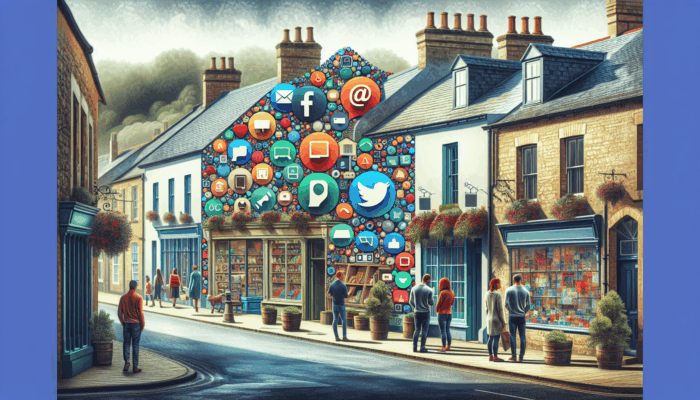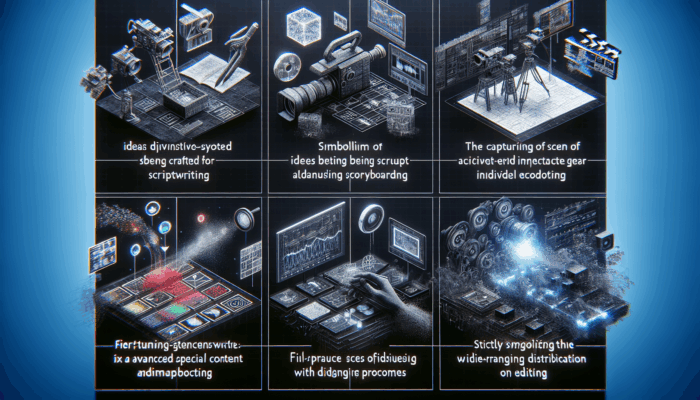Table of Contents
ToggleDiving Deep into the Diverse Landscape of Digital Media
Uncovering the Varied Types of Digital Media That Enhance Audience Engagement

digital media and marketing encompass an extensive array of formats that go well beyond the constraints of traditional media. This expansive realm includes the interactive dimensions of social media platforms, such as Facebook and Instagram, alongside the immersive storytelling that podcasts and videos deliver. Each medium presents unique features tailored to meet the varied preferences of different audiences. Notably, social media thrives on user interactivity, allowing individuals to connect, share, and engage in real-time discussions. This vibrant interactivity fosters a robust sense of community and strengthens brand loyalty, making it an essential component of modern digital media and marketing strategies.
Moreover, video content serves as a powerful tool for storytelling, breaking down language barriers and functioning as a universal means of communication. Platforms like YouTube and TikTok feature short yet captivating narratives that draw in audiences while delivering messages succinctly. The rise of live streaming has further transformed how brands connect with consumers, encouraging genuine and spontaneous interactions. In parallel, podcasts offer an intimate listening experience, allowing brands to build credibility and foster a dedicated following through in-depth conversations and captivating narratives.
These diverse forms of digital media cater effectively to varied audience preferences, enabling marketers to tailor messages that resonate with their target demographics. Understanding these distinctions is crucial for unlocking the full potential of each medium, ensuring brands can effectively engage and connect with a diverse array of global audiences.
Tracing the Transformation of Digital Media Over Time
The evolution of digital media has been characterised by rapid technological advancements and significant shifts in consumer behaviour. In its infancy, the internet primarily served as a static repository of information, with early websites providing minimal interactivity. However, the advent of social media platforms in the early 2000s transformed the landscape of content creation and consumption. Platforms such as Facebook and Twitter empowered users to share their thoughts, experiences, and media, marking the dawn of user-generated content.
As internet connectivity expanded, the proliferation of smartphones profoundly altered the media landscape. The emergence of mobile applications facilitated instant access to information and entertainment, making content consumption more personalised and immediate. Today, platforms like Instagram and TikTok dominate the digital realm, driven by the appeal of visual storytelling and short-form content that aligns with the evolving consumer desire for quick, digestible information.
The advancement of digital media and marketing also highlights the growing importance of data analytics. Brands now leverage sophisticated algorithms and insights to understand audience behaviour, tailor their messaging, and enhance engagement. This data-driven approach not only boosts marketing effectiveness but also fosters a more personalised consumer experience that resonates with individual preferences.
Understanding the Significant Influence of Digital Media on Society
The impact of digital media on societal dynamics is profound, influencing cultural norms, communication patterns, and consumer behaviours on a global scale. Platforms such as Twitter have become essential spaces for societal discourse, allowing individuals to voice opinions on pressing issues ranging from politics to social justice. This democratisation of information has sparked movements capable of mobilising support swiftly and effectively, showcasing the power of digital platforms in driving social change.
Furthermore, digital media has redefined traditional marketing paradigms. Consumers have evolved from passive recipients of information to active participants in content creation and dissemination. Brands must navigate this intricate landscape carefully, as consumer trust hinges on authenticity and transparency. Elements of social proof, such as reviews and testimonials, significantly influence purchasing decisions, making it essential for brands to engage with their audiences meaningfully.
The repercussions of digital media and marketing extend into mental health as well. While connections forged through digital platforms can foster a sense of belonging, they may also lead to feelings of isolation and anxiety. This duality underscores the importance of media literacy, equipping individuals to critically assess the content they consume and understand its effects on their well-being.
Recognising the Vital Importance of Digital Media Literacy

In a world increasingly dominated by digital media, possessing media literacy has become an indispensable skill set. The ability to critically assess digital content is crucial for successfully navigating the complexities of today’s information environment. Individuals must learn to distinguish credible sources from unverified information—a challenge that has intensified with the surge of misinformation and sensationalised content.
Education systems across the globe are progressively recognising the urgent need to incorporate digital literacy into their curricula. This includes teaching students how to critically analyse media messages, understand various formats, and evaluate the societal impacts of digital content. By cultivating these skills, educators empower young individuals to engage responsibly with digital media and make informed decisions that profoundly affect their interactions.
In addition, digital media literacy encompasses a comprehensive understanding of the tools and technologies used in digital marketing. Professionals in this realm must be adept at using analytics tools to assess campaign performance and adjust strategies as needed. This commitment to continuous learning ensures that marketers remain relevant in a rapidly evolving digital landscape, equipping them to engage diverse audiences effectively.
Preparing for the Future of Digital Media
As we look ahead, the landscape of digital media is set to be shaped by emerging technologies and changing consumer behaviours. Artificial intelligence is poised to play a crucial role, automating content creation, personalising user experiences, and enhancing data analysis. This not only streamlines marketing processes but also facilitates more tailored communication with consumers, potentially boosting engagement and conversion rates.
Moreover, virtual reality and augmented reality stand at the cutting edge of the digital media frontier. These immersive technologies open up new avenues for storytelling and brand experiences, allowing consumers to interact with products and services in innovative ways. From virtual try-ons in retail to engaging brand experiences at events, the possibilities for interaction are extensive.
Additionally, as concerns regarding data privacy and security continue to grow, the digital media landscape is likely to shift towards greater transparency and ethical practices. Brands that prioritise ethical considerations in their digital marketing strategies will cultivate trust and loyalty among consumers, positioning themselves as leaders in the ever-evolving digital ecosystem.
Fundamental Principles of Digital Marketing for Achieving Success
Key Marketing Concepts Every Business Must Understand

A comprehensive understanding of the core concepts of digital marketing is essential for businesses aiming to succeed in the online marketplace. Central to these strategies are vital terms such as Search Engine Optimisation (SEO), Search Engine Marketing (SEM), and content marketing. SEO involves the optimisation of website content to achieve higher rankings in search engine results, thus enhancing visibility and driving organic traffic to the site.
On the other hand, SEM includes paid strategies, such as pay-per-click (PPC) advertising, where brands bid on specific keywords to gain visibility on search engines. This synergistic approach of combining SEO with SEM enables marketers to maximise their reach and effectiveness, ensuring they connect with audiences at every stage of the buyer’s journey.
Content marketing focuses on creating valuable, relevant content designed to attract and engage a target audience. This strategy enhances brand awareness and positions companies as thought leaders within their industries. By delivering informative and entertaining content, brands can build strong relationships with their audience, ultimately driving conversions and fostering customer loyalty.
Integrating these concepts into a cohesive digital marketing strategy requires a deep understanding of audience behaviour, preferences, and trends. Brands must consistently monitor these variables and adapt their approaches to remain relevant in a constantly evolving digital landscape.
Identifying the Most Effective Marketing Channels for Your Brand
The success of a digital marketing strategy heavily depends on the careful selection of appropriate marketing channels. With a plethora of platforms available—from social media networks to email newsletters—marketers must thoroughly evaluate where their target audience spends their time and how they prefer to engage with content.
Social media platforms such as Facebook, Instagram, and LinkedIn offer dynamic environments for brands to interact directly with users. These platforms facilitate two-way communication, enabling real-time feedback and engagement. Brands can harness user-generated content and social proof to enhance their credibility and cultivate a sense of community.
Email marketing remains a highly effective tool within the digital marketing arsenal. With the potential for a high return on investment, targeted email campaigns can effectively nurture leads and maintain customer relationships. Personalisation plays a crucial role; tailored messages resonate more deeply with recipients, thus increasing the likelihood of engagement and conversion.
Furthermore, emerging platforms such as TikTok and Snapchat are reshaping marketing dynamics, particularly among younger audiences. Brands that embrace these channels can tap into new trends and cultural conversations, establishing themselves as contemporary and relevant.
Ultimately, the key to successful digital marketing lies in understanding which channels align with specific marketing goals and the characteristics of the target audience.
Measuring Success Through Key Performance Indicators and Metrics
The effectiveness of any digital marketing campaign hinges on accurately measuring success. Metrics and analytical tools provide invaluable insights into campaign performance, enabling marketers to evaluate their strategies and make informed, data-driven decisions.
Key performance indicators (KPIs) such as click-through rates (CTR), conversion rates, and return on investment (ROI) are fundamental in assessing overall success. Monitoring these metrics helps marketers comprehend how well their content resonates with audiences while identifying areas that require improvement.
Analytics tools like Google Analytics offer comprehensive data regarding user behaviour, allowing marketers to delve deeper into audience engagement and interactions. By analysing traffic sources, user demographics, and behaviour flows, brands can refine their strategies to effectively target specific segments.
Moreover, A/B testing is a vital methodology for measuring success. By testing different variations of content, designs, or calls to action, marketers can discover which elements yield the best results. This iterative approach promotes continuous improvement and optimisation, ensuring that marketing efforts are both effective and efficient.
In the dynamic realm of digital marketing, the ability to measure and analyse success is a critical component of any strategy, guiding brands toward achieving their objectives.
Creating Engaging Content That Connects with Your Audience
Developing a Holistic Content Strategy for Maximum Impact
Establishing a robust content strategy is fundamental to successful digital marketing. A well-designed strategy not only defines the types of content to be produced but also sets clear objectives, identifies target audiences, and outlines suitable distribution channels. The initial step involves conducting comprehensive research to understand audience preferences, behaviours, and challenges.
Once the target audience is established, content creators can tailor their messaging to resonate with specific segments. This may involve crafting buyer personas, which encapsulate the characteristics, demographics, and needs of target audiences. By integrating these personas into the content creation process, brands can develop content that speaks directly to their audience’s interests and motivations.
Furthermore, a content calendar can be invaluable for planning and organising content production. By scheduling posts and themes in advance, brands can maintain a consistent flow of content that aligns with marketing objectives. This not only keeps the audience engaged but also allows opportunities to capitalise on seasonal trends or relevant industry events.
Additionally, measuring the performance of various content types—be it blog posts, videos, or social media updates—enables marketers to refine their strategies based on what resonates most with their audience. This data-driven approach ensures that content remains relevant and engaging, ultimately achieving the desired marketing goals.
Utilising Storytelling Techniques to Amplify Engagement
The art of storytelling plays a pivotal role in digital media and marketing. Compelling narratives captivate audiences, evoke emotions, and foster connections between brands and consumers. By weaving engaging stories into their content, brands can convey messages more powerfully and memorably, creating lasting impressions.
Effective storytelling begins with a clear grasp of the brand’s core values and unique selling propositions. These elements form the foundation of the narrative and shape the messaging strategy. Brands should aim to create relatable characters and scenarios that resonate with the audience’s experiences, making the content more engaging and accessible.
Visual elements significantly enhance storytelling by providing context and capturing attention. Infographics, animations, and videos can illustrate complex concepts, rendering them easier to digest and share. Moreover, incorporating user-generated content into brand narratives reinforces authenticity and nurtures a sense of community, as audiences see their experiences reflected in the brand’s story.
Finally, seamlessly integrating call-to-action elements within storytelling is crucial. These prompts guide the audience toward desired actions and reinforce the narrative’s purpose. Whether it’s signing up for a newsletter or making a purchase, a well-placed call to action can significantly influence conversion rates, driving business growth.
Engaging storytelling not only enhances content but also positions brands as relatable and trustworthy, fostering long-term consumer loyalty and advocacy.
Enriching Content with Visual and Multimedia Elements
In the domain of digital marketing, integrating visual and multimedia elements is essential for enhancing the appeal and engagement of content. The human brain processes visuals significantly faster than text, making it imperative for brands to incorporate visual strategies into their content.
Images, videos, and interactive media effectively capture attention and convey information succinctly. For example, infographics simplify complex data into digestible visuals, enabling audiences to grasp insights quickly and effectively. Brands can leverage these tools on social media platforms, where eye-catching visuals can lead to higher engagement rates and encourage users to share content.
Videos, particularly, have surged in popularity within digital media, offering a dynamic means to communicate messages. Whether through product demonstrations, tutorials, or behind-the-scenes insights, video content can foster emotional connections and drive viewer engagement. Live streaming has emerged as a powerful tool for real-time interaction, allowing brands to authentically engage with their audience.
Moreover, incorporating interactive media such as polls, quizzes, and interactive infographics significantly enhances user engagement. These elements encourage participation, making the audience feel involved and valued. By creating content that invites interaction, brands can foster a sense of community and loyalty among their consumers, reinforcing their brand message.
In summary, leveraging visual and multimedia elements is vital for crafting content that captures attention, enhances messaging, and drives engagement, ultimately contributing to the success of digital marketing initiatives.
Encouraging Audience Interaction and Gathering Valuable Feedback
Fostering audience interaction and gathering feedback are essential components of a successful digital marketing strategy. Actively engaging with consumers across various platforms creates a dialogue that strengthens relationships and builds brand loyalty. Successful brands encourage interactions by responding to comments, hosting Q&A sessions, and initiating discussions around trending topics.
Feedback mechanisms, such as surveys and polls, provide invaluable insights into consumer preferences and experiences. By actively seeking input, brands demonstrate that they value their audience’s opinions and are willing to adapt their strategies based on the feedback received. This not only enhances customer satisfaction but also drives continuous improvement in products and services.
User-generated content is another powerful tool for fostering audience interaction. Encouraging customers to share their experiences, reviews, or creative uses of products fosters a sense of community and authenticity. Brands can amplify this content through reposts or shares, showcasing real-life applications and building trust with potential customers.
Integrating audience feedback into content strategies allows brands to remain agile and responsive to consumer needs. Regularly analysing engagement metrics and feedback can reveal trends, enabling marketers to pivot their strategies effectively. Ultimately, prioritising audience interaction enriches the consumer experience, creating loyal advocates who contribute to long-term brand success.
Maximising the Benefits of Social Media for Brand Growth
Selecting the Most Appropriate Social Media Platforms for Effective Engagement
Choosing the right social media platforms is crucial for achieving marketing objectives in a continuously evolving digital landscape. Each platform possesses distinct characteristics and user demographics, making it essential for brands to tailor their marketing strategies to the specific nuances of each medium.
For instance, platforms such as Instagram and TikTok are inherently visual and predominantly cater to younger audiences. Brands aiming to engage this demographic may find success by leveraging these channels through captivating visual content, engaging stories, and fostering organic interactions. Conversely, LinkedIn serves as a professional networking platform, making it ideal for B2B marketing and thought leadership content targeted at industry professionals.
Understanding audience behaviour is vital when selecting platforms. Conducting demographic research can reveal where target consumers spend their time and which platforms they prefer for engaging with content. Brands should also consider the types of content that thrive on each platform; for example, short-form videos excel on TikTok, while longer, more in-depth articles may resonate better on LinkedIn.
Ultimately, the key lies in a strategic approach that aligns platform selection with target audience characteristics and marketing goals. By leveraging the strengths of each platform, brands can effectively reach diverse audiences and enhance their digital marketing efforts.
Implementing Effective Engagement Strategies for Brand Loyalty
Crafting impactful social media engagement strategies is essential for building community and fostering brand loyalty. Brands must move beyond one-way communication to create meaningful interactions with their audience. Encouraging user participation through polls, contests, and interactive stories invites consumers to share their thoughts and experiences, cultivating a sense of belonging and connection.
Regularly hosting live sessions or Q&A events can also enrich engagement. These real-time interactions establish authenticity and provide audiences with a platform to connect directly with brands. Prompt response times are crucial; addressing comments and messages swiftly demonstrates a commitment to customer care, which in turn fosters stronger relationships and trust.
Diversifying content formats is another effective strategy for maintaining audience interest. Mixing various formats—such as videos, infographics, and user-generated content—ensures varied engagement and caters to different preferences. Sharing behind-the-scenes glimpses or employee stories humanises a brand, creating relatable narratives that resonate with consumers.
Moreover, leveraging analytics tools to monitor engagement metrics can guide improvements in social media strategies. Understanding which posts generate the most interaction allows marketers to refine their content and timing. By continuously adapting to audience preferences, brands can cultivate a loyal community that champions their message.
Utilising Analytics and Insights for Ongoing Improvement
Utilising analytics and insights is critical for refining social media strategies and optimising outcomes in digital marketing. Data-driven decision-making enables brands to assess the effectiveness of their campaigns and optimise their content to resonate better with audiences.
Social media platforms provide robust analytics tools that offer invaluable insights into audience demographics, engagement rates, and content performance. By analysing this data, brands can identify trends and patterns that inform tailored messaging and posting strategies to maximise engagement.
Key performance indicators (KPIs), such as reach, impressions, and click-through rates, help brands evaluate their success on social media. Monitoring these metrics over time enables marketers to gauge the effectiveness of different types of content and adjust their strategies accordingly, ensuring ongoing relevance and impact.
A/B testing is another powerful method for gaining insights. Testing variations of posts—such as different headlines, visuals, or calls to action—can reveal what resonates most with audiences. By implementing these insights, brands can refine their approach, ensuring that content remains engaging and impactful.
Ultimately, leveraging analytics is essential for driving continuous improvement in social media strategies, enabling brands to adapt to shifting audience preferences and achieve their digital marketing objectives.
Mastering Search Engine Optimisation (SEO) for Online Success
Implementing Effective On-Page SEO Techniques for Enhanced Visibility
On-page SEO techniques are fundamental for optimising website content and structure to boost visibility on search engines. By ensuring that each page is well-structured and relevant, brands can significantly enhance their likelihood of ranking higher in search results and attracting organic traffic.
The first step involves conducting comprehensive keyword research to identify relevant terms and phrases that prospective customers are searching for. Strategically incorporating these keywords within website content—such as in titles, headings, and body text—enhances search relevance. However, it is critical to maintain a natural flow of language to ensure that the content remains engaging and valuable to readers.
Optimising meta tags, including title tags and meta descriptions, is also crucial. These elements provide search engines with context about the content of each page, which subsequently influences click-through rates. Crafting compelling meta descriptions that include relevant keywords encourages users to click on search results, thereby driving more traffic to the site.
Additionally, incorporating internal and external links enhances a website’s credibility. Internal links guide users to related content within the site, improving navigation and engagement. External links to reputable sources demonstrate authority and provide additional value to readers, further enhancing SEO performance and user experience.
In summary, executing effective on-page SEO techniques is integral to increasing visibility in search results, driving organic traffic, and enhancing the overall user experience on a website.
Strategic Off-Page SEO for Building Brand Authority
Off-page SEO strategies play a crucial role in influencing a website’s search engine ranking through external factors. These strategies focus on promoting a brand beyond its website, enhancing its authority and credibility in the eyes of search engines.
Backlinking is one of the most effective off-page SEO tactics. High-quality backlinks from reputable websites signal to search engines that a brand is a trusted authority within its industry. Brands can cultivate these relationships through guest blogging, partnerships, and collaborations, which not only enhance SEO but also expand their reach to new audiences.
A strong social media presence also contributes to off-page SEO. Sharing content on social platforms increases visibility and encourages shares and engagement. When audiences interact with brand content on social media, it can drive traffic back to the website, further enhancing ranking potential and overall visibility.
Online reputation management is another crucial aspect of off-page SEO. Positive reviews and testimonials on platforms like Google, Yelp, or TripAdvisor can significantly influence search rankings and bolster consumer trust. Brands should actively manage their online reputation by encouraging satisfied customers to leave reviews and responding promptly to any feedback received.
By adopting a comprehensive off-page SEO strategy, brands can enhance their online presence, boost search rankings, and ultimately drive more organic traffic to their websites.
Utilising Essential SEO Tools and Resources for Success
Utilising SEO tools and resources is vital for effectively monitoring and enhancing SEO efforts. A variety of tools are available to assist brands in conducting keyword research, tracking rankings, and analysing website performance.
Google Analytics is a powerful tool that provides insights into website traffic, user behaviour, and conversion rates. By monitoring these metrics, brands can identify areas for improvement and adjust their strategies accordingly. Additionally, Google Search Console offers valuable insights into how a website performs in search results, including information on indexing issues and keyword rankings.
Keyword research tools such as SEMrush and Ahrefs help brands discover relevant keywords and assess their competitiveness. This information is critical for developing effective content strategies that align with user search intent and drive targeted traffic.
Moreover, SEO audit tools can analyse website structure, identifying technical issues that may hinder performance. By addressing these issues—such as broken links, slow loading times, or lack of mobile optimisation—brands can enhance user experience and improve search rankings.
Investing in these tools and resources ensures that brands stay ahead of the competition and effectively optimise their SEO strategies to achieve long-term success and visibility in the digital landscape.
Addressing Technical SEO Considerations for Optimal Performance
Technical SEO encompasses various aspects that impact website performance and search engine rankings. Addressing these considerations is paramount for ensuring that a site is accessible and user-friendly, ultimately enhancing its visibility in search results.
Website speed is one of the most critical technical SEO factors. Slow loading times can lead to increased bounce rates and negatively affect user experience. Brands should optimise images, leverage browser caching, and minimise HTTP requests to improve site speed. Tools like Google PageSpeed Insights provide valuable feedback on performance and areas for improvement.
Mobile-friendliness is another vital factor, as a growing number of users access websites via mobile devices. Ensuring that a site is responsive and caters to mobile users not only enhances user experience but also aligns with search engine ranking criteria. Google’s mobile-first indexing prioritises mobile-optimised sites in search results, making mobile-friendliness crucial for success.
Structured data and schema markup are additional technical considerations that can improve search visibility. Implementing structured data enables search engines to better understand the content of a webpage, allowing for enhanced rich snippets in search results, such as star ratings or prices, which can significantly impact click-through rates.
By prioritising technical SEO considerations, brands can create a seamless user experience, ensure accessibility, and improve their overall search engine performance, positioning themselves favourably in the competitive digital landscape.
Emerging Trends and Technologies That Are Shaping Digital Marketing
Harnessing the Power of Artificial Intelligence in Marketing Strategies
Artificial intelligence (AI) is transforming digital marketing by introducing automation, personalisation, and data-driven insights. AI tools can rapidly analyse vast amounts of data, allowing marketers to gain a deeper understanding of consumer behaviour and preferences more effectively than ever before.
Chatbots represent one of the most visible applications of AI in marketing. These automated tools can interact with customers in real time, answering queries, providing personalised recommendations, and guiding users through various stages of the buying process. This not only improves customer service but also frees up human resources for more complex tasks, enhancing operational efficiency.
AI-driven analytics tools enable brands to predict trends and consumer behaviour based on historical data. Machine learning algorithms can identify patterns that inform targeted marketing strategies, ensuring that brands connect with their audiences at the right time with the right message. This high level of personalisation boosts engagement rates and fosters stronger consumer relationships, enhancing brand loyalty.
Moreover, AI enhances content creation. Tools powered by artificial intelligence can generate articles, social media updates, and even videos, streamlining content production processes. While human oversight remains essential for quality control, AI can considerably reduce the time and effort required to create engaging content that resonates with audiences.
As AI technology continues to advance, its integration into digital marketing strategies will further enhance brands’ capacity to connect with consumers in meaningful and innovative ways, paving the way for future advancements.
Utilising Augmented and Virtual Reality for Immersive Consumer Experiences
Augmented reality (AR) and virtual reality (VR) are emerging technologies that offer unprecedented opportunities for creating immersive marketing experiences. These technologies enable brands to craft engaging environments that allow consumers to interact with products in innovative ways, thereby enhancing product experiences and driving deeper engagement.
AR technology overlays digital elements onto the real world, enabling consumers to engage with products in their immediate surroundings. For instance, retailers like IKEA have implemented AR applications that permit users to visualise furniture in their homes prior to purchase. This not only enriches the shopping experience but also reduces the likelihood of returns, as consumers gain a clearer understanding of how products fit into their lives.
VR, conversely, creates entirely immersive environments that transport users to different realities. Brands can use VR experiences for virtual tours, product demonstrations, or experiential marketing campaigns. For example, travel companies can offer virtual experiences of destinations, allowing potential customers to explore locations before booking trips, thereby enhancing their decision-making processes.
Both AR and VR enable brands to create memorable experiences that resonate with consumers, fostering emotional connections and enhancing brand loyalty. As these technologies become more accessible, their integration into digital marketing strategies will undoubtedly shape the future of consumer engagement.
Forecasting the Future of Digital Media and Marketing Trends
The future of digital media is set for transformative changes, driven by technological advancements and evolving consumer expectations. Emerging trends indicate a shift towards greater personalisation, improved user experiences, and ethical considerations regarding data usage.
As artificial intelligence continues to develop, brands will increasingly leverage machine learning algorithms to deliver hyper-personalised content to users. This will not only enhance engagement but also ensure that consumers receive information aligned with their interests and behaviours, ultimately driving conversions and satisfaction.
Moreover, the rise of voice search and smart assistants will reshape how consumers interact with content. Brands must optimise their SEO strategies to accommodate this shift, focusing on conversational keywords and phrases that users employ when speaking queries, thereby ensuring their content remains discoverable.
Ethical considerations surrounding data privacy will also significantly influence the future of digital media and marketing. Consumers are becoming increasingly aware of their data rights, leading to heightened demands for transparency and accountability from brands. Companies that prioritise ethical data practices will build trust and foster stronger relationships with their audiences, ultimately enhancing brand reputation and loyalty.
In conclusion, the future of digital media presents exciting opportunities for brands willing to adapt and innovate, shaping the way they engage with consumers within a rapidly evolving digital landscape.
Exploring the Role of Blockchain Technology in Digital Advertising
Blockchain technology is gaining momentum in the digital advertising realm, offering enhanced transparency and security in advertising transactions. This decentralised ledger system has the potential to address numerous challenges within the advertising ecosystem, including fraud, data privacy, and trust issues.
One of the most significant advantages of blockchain is its capacity to provide transparent tracking of advertising expenditure. Brands can verify where their advertising dollars are allocated, ensuring that funds are not misallocated or squandered. This transparency fosters accountability among stakeholders and builds trust between advertisers and publishers.
Additionally, blockchain can combat advertising fraud by providing a secure, tamper-proof record of transactions. Advertisers can ensure their ads are shown to real users, thereby reducing the risk of fraudulent clicks or impressions. This protects brand budgets and enhances the overall effectiveness of advertising campaigns.
Moreover, blockchain technology empowers consumers by granting them greater control over their data. With decentralised systems, users can choose to share their information with brands, leading to more ethical data practices and heightened consumer trust.
As blockchain technology continues to evolve, its integration into digital advertising strategies will revolutionise the industry, paving the way for more secure, transparent, and ethical advertising practices that benefit all parties involved.
Addressing Common Inquiries Regarding Digital Media and Marketing
What is classified as digital media?
Digital media refers to content that is created, shared, and consumed in a digital format, encompassing videos, podcasts, social media posts, and websites, all of which are integral to contemporary communication.
How has digital marketing changed over the years?
Digital marketing has evolved from static websites to dynamic, interactive platforms, incorporating social media, data analytics, and automated tools to implement more targeted and effective strategies.
What are the key components of a successful digital marketing strategy?
A successful digital marketing strategy encompasses clear objectives, a thorough understanding of the target audience, strategic platform selection, well-crafted content creation, and ongoing analysis of performance metrics to refine approaches.
Why is SEO crucial in digital marketing?
SEO is essential for increasing a website’s visibility in search engine results, driving organic traffic, and improving the overall user experience through optimised content that resonates with target audiences.
What methods can brands utilise to measure the success of their digital marketing campaigns?
Brands can measure success through key performance indicators (KPIs) such as conversion rates, click-through rates, and overall return on investment (ROI), which provide valuable insights into campaign effectiveness.
What role does social media play in the realm of digital marketing?
Social media serves as a platform for brands to engage with audiences, build community, and promote content, significantly enhancing brand visibility and customer relationships through interactive engagement.
How can companies create content that resonates with their audience?
Companies can create engaging content by thoroughly understanding their target audience, employing effective storytelling techniques, and incorporating visuals and multimedia elements that enhance overall impact.
What are the most notable emerging trends in digital marketing?
Emerging trends include the use of artificial intelligence for personalisation, the rise of augmented and virtual reality for immersive experiences, and an increased focus on ethical data practices that prioritise consumer privacy.
What influence does digital media have on consumer behaviour?
Digital media significantly impacts consumer behaviour by shaping perceptions, driving engagement, and providing immediate access to information and reviews that inform purchasing decisions.
How can brands ensure ethical practices in their digital marketing efforts?
Brands can ensure ethical practices by prioritising transparency in data usage, obtaining consumer consent, and being accountable for their marketing strategies and communications, thereby building trust and credibility.
Connect with us on Facebook!
The post Digital Media and Marketing: Strategies for Success appeared first on Ezi Gold.
















